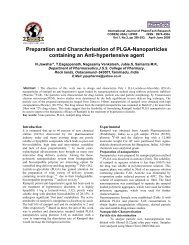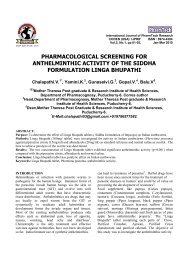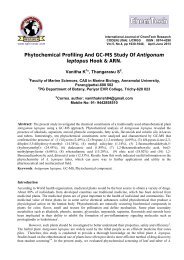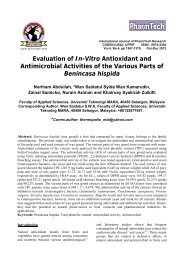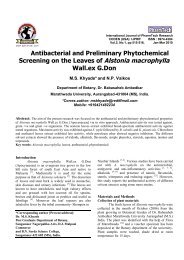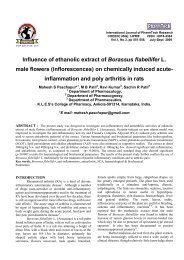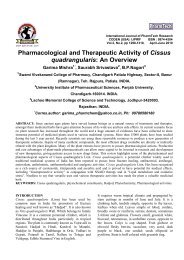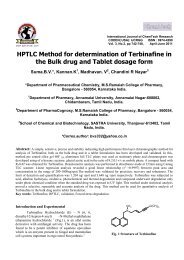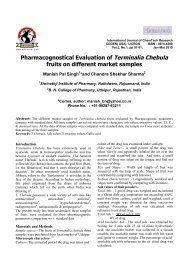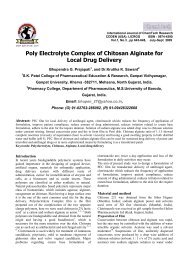Formulation & Evaluation of Centella asiatica extract impregnated ...
Formulation & Evaluation of Centella asiatica extract impregnated ...
Formulation & Evaluation of Centella asiatica extract impregnated ...
You also want an ePaper? Increase the reach of your titles
YUMPU automatically turns print PDFs into web optimized ePapers that Google loves.
International Journal <strong>of</strong> PharmTech Research<br />
CODEN (USA): IJPRIF ISSN : 0974-4304<br />
Vol.3, No.3,pp 1382-1391, July-Sept 2011<br />
<strong>Formulation</strong> & <strong>Evaluation</strong> <strong>of</strong> <strong>Centella</strong> <strong>asiatica</strong><br />
<strong>extract</strong> <strong>impregnated</strong> Collagen Dermal<br />
Scaffolds for Wound healing<br />
M. Kishore Babu* 1 , B.VamsiKrishan 2 , & T.E.G.K. Murthy 3<br />
1 Department <strong>of</strong> Pharmaceutics, Bapatla College <strong>of</strong> Pharmacy, Bapatla,<br />
Andhra Pradesh, India.<br />
2 Production Executive, Orchid Pharmaceuticals, Chennai, India<br />
3 Principal, Bapatla College <strong>of</strong> Pharmacy, Bapatla, Andhra Pradesh, India<br />
Corres. Author: kishorecollagen@gmail.com<br />
Mobile no.: +91-9949415680, Tel.No:08643-224144<br />
Fax: 08643-221407<br />
Abstract: The aim <strong>of</strong> this work is to design and formulate a collagen based dermal scaffold containing <strong>Centella</strong><br />
<strong>asiatica</strong> <strong>extract</strong> for the improvement in the quality <strong>of</strong> wound healing. For this purpose Collagen was isolated from<br />
bovine Achilles tendon and tested for its confirmation <strong>of</strong> presence, purity and sterility. The physicochemical<br />
compatibility between collagen and <strong>Centella</strong> <strong>asiatica</strong> <strong>extract</strong> was studied by FT-IR and results obtained suggested no<br />
interaction and they were compatible. Collagen based Scaffolds were formulated using different concentrations (1%w/v,<br />
1.5%w/v & 2%w/v) <strong>of</strong> <strong>Centella</strong> <strong>asiatica</strong> <strong>extract</strong> (CAEICDS- <strong>Centella</strong> <strong>asiatica</strong> <strong>extract</strong> incorporated collagen dermal<br />
scaffolds). The prepared scaffolds were subjected to physical, biochemical and histopathological examinations.<br />
Microshrinkage Temperature <strong>of</strong> the scaffolds containing 1%w/v & 1.5%w/v & 2%w/v <strong>of</strong> CAEICDS were found to be<br />
69 0 C, 71 0 C & 72 0 C respectively indicating their hydrothermal stability. Wound healing studies on Male Wister Rats<br />
were performed for a period <strong>of</strong> 7 days and it was observed that the 1.5%w/v CAEICDS treated rats possessed higher<br />
amount <strong>of</strong> hydroxyl proline content (71.3%) when compared to that <strong>of</strong> the existing Marketed formulation (Neu- skin TM )<br />
(59.7%). Further better wound healing activity was observed in the 1.5%w/v CAEICDS treated rats (79.9%) when<br />
compared to others which included the Marketed formulation (55.2%). When examined histopathologically, more<br />
production in the collagen content was clearly observed in 1.5% w/v CAEICDS treated groups which resulted in the<br />
epithelial gap reduction. Further rise in fibroblasts (69 in 100µ in the wound during the healing process) in 1.5% w/v<br />
CAEICDS treated groups suggested that it is a feasible and productive approach in the improvement <strong>of</strong> dermal wound<br />
healing process.<br />
Keywords: Collagen, <strong>Centella</strong> <strong>asiatica</strong> <strong>extract</strong>, Micro Shrinkage Temperature, Wound Healing, Histopathological<br />
Examination.
M. Kishore Babu /Int.J. PharmTech Res.2011,3(3) 1383<br />
1. INTRODUCTION:<br />
Wound Repair is a multifactorial task involving<br />
several events finally restoring to normal<br />
conditions 1 .The steps in the healing <strong>of</strong> the wound<br />
include inflammation, proliferation, and migration <strong>of</strong><br />
different cell types. Inflammation, the first phase<br />
occurs immediately after injury and is known as<br />
coagulation which results in a coordinated influx <strong>of</strong><br />
neutrophils at the woundsite.These cells has a natural<br />
tendency <strong>of</strong> respiratory burst mechanism and produce<br />
free radicals. Certain non phagocytic cells <strong>of</strong> the<br />
wound generate radicals by the non-phagocytic<br />
NAD(P)H oxidase mechanism making the wound site<br />
rich in oxygen and nitrogen. These free radicals<br />
present causes oxidative stress to the system giving<br />
pavement to lipid peroxidation, DNA breakage and<br />
enzyme inactivation including the free radical<br />
scavenging enzymes 2 .There is a substantial evidence<br />
<strong>of</strong> antioxidants playing a vital role in therapy against<br />
the pathogenesis <strong>of</strong> many diseases caused by<br />
oxidants 3 . <strong>Centella</strong> <strong>asiatica</strong> <strong>extract</strong>, a naturally<br />
occurring <strong>extract</strong> rich in tannins and phenolic<br />
derivative has shown to possess several biological<br />
properties including antioxidant property (free radical<br />
scavenging activity) 4,5 , However the delivery <strong>of</strong> this<br />
<strong>extract</strong> possessing the wound healing properties<br />
becomes a matter <strong>of</strong> concern. <strong>Centella</strong> <strong>asiatica</strong> <strong>extract</strong><br />
incorporated Collagen in the form <strong>of</strong> Scaffold ensures<br />
slow release <strong>of</strong> drug providing the better therapy by<br />
acting as a physical support for cellular<br />
proliferation 6 .Moreover, Collagen itself acts as a<br />
wound healing agent possessing biodegradable and<br />
biocompatible properties provide the synergistic<br />
activity in significant wound healing along with the<br />
drug.<br />
2. MATERIALS AND METHODS<br />
Materials:<br />
Collagen (isolated from Achilles tendon), <strong>Centella</strong><br />
<strong>asiatica</strong> aqueous <strong>extract</strong> - gift sample obtained from<br />
Chemiloids –Vijayawada, oleic acid, 2, 2 0azobisisobutyronitrile<br />
(AIBN) were purchased from<br />
Merck (India). All other chemicals used in this<br />
research activity were <strong>of</strong> analytical grade.<br />
Animals:<br />
Male Wistar rats weighing between 150-200 grams<br />
obtained from the animal house <strong>of</strong> Bapatla College <strong>of</strong><br />
Pharmacy (1032/ac/07/CPCSEA), Bapatla, were<br />
maintained at a constant temperature <strong>of</strong> 26± 2 0 c and<br />
humidity at 30-40% with 12 h light and dark cycle<br />
throughout the experiment. The animals were housed<br />
in clean polypropylene cages in an air-conditioned<br />
animal house and were fed with commercial rat feed<br />
and sterile water. The experiment protocol IAEC/<br />
II/16 /BCOP/2009 was approved by the<br />
Institutional Animal Ethical Committee <strong>of</strong> Bapatla<br />
College <strong>of</strong> Pharmacy.<br />
Methods:<br />
2.2.1. Investigation <strong>of</strong> physicochemical<br />
compatibility <strong>of</strong> <strong>Centella</strong> <strong>asiatica</strong> <strong>extract</strong> and<br />
polymer:<br />
Collagen was isolated from Bovine Achilles tendon<br />
using 0.5M acetic acid and 5% w/v Nacl solution<br />
following the previously reported procedure 6 . The<br />
physicochemical compatibility between <strong>Centella</strong><br />
<strong>asiatica</strong> <strong>extract</strong> and collagen was studied by using<br />
Perkin Elmer Fourier Transform Infra Red (FTIR)<br />
Spectroscopy. The infrared spectra were recorded<br />
using Perkin Elmer Fourier Transform Infra Red<br />
(FTIR) Spectrometer, Shelton, USA by using KBr<br />
pellet method and spectra were recorded in the<br />
wavelength region between 4000 and 400 cm -1 . The<br />
spectra obtained for <strong>Centella</strong> <strong>asiatica</strong> <strong>extract</strong>, collagen<br />
and physical mixture <strong>of</strong> <strong>Centella</strong> <strong>asiatica</strong> <strong>extract</strong> with<br />
collagen were compared.<br />
2.2.2 Development <strong>of</strong> <strong>Centella</strong> <strong>asiatica</strong> <strong>extract</strong><br />
Impregnated Collagen Based Dermal Scaffolds<br />
(CAEICDS):<br />
Collagen was soaked in 0.05 M glacial acetic acid at<br />
25mg/ml concentration for 24 hrs at 4 0 c.The obtained<br />
viscous solution was homogenized for 5 min,<br />
deaerated for 15 min by using sonicator and squeezed<br />
through muslin cloth to get rid <strong>of</strong> undissolved solid<br />
traces if any. Various solutions with different<br />
concentrations <strong>of</strong> <strong>Centella</strong> <strong>asiatica</strong> <strong>extract</strong> such as<br />
1%w/v & 1.5%w/v & 2%w/v previously dry heat<br />
sterilized were separately solublized in 3ml <strong>of</strong> absolute<br />
ethanol. The prepared solutions were mixed with 18ml<br />
<strong>of</strong> collagen solution (concentration <strong>of</strong> collagen<br />
adjusted to 11mg/ml, with 0.05 m acetic acid) with<br />
constant stirring for 24 h, at 4 0 c. The suspension was<br />
then squeezed through muslin cloth to remove any<br />
precipitate formed during the process. The viscous<br />
dispersion thus obtained was deaerated by sonication<br />
and casted in Petri plate (64 cm 2 diameter) having<br />
polyethylene membrane base and placed in incubator<br />
at 37 0 c until dried. The scaffold thus obtained was<br />
sterilized under UV radiation for a period <strong>of</strong> 18 hours<br />
and subjected to microbial studies.
M. Kishore Babu /Int.J. PharmTech Res.2011,3(3) 1384<br />
Figure: 1: FT-IR <strong>of</strong> <strong>Centella</strong> <strong>asiatica</strong> <strong>extract</strong><br />
Figure: 2: FT-IR <strong>of</strong> plain collagen scaffold.
M. Kishore Babu /Int.J. PharmTech Res.2011,3(3) 1385<br />
Figure: 3: FT-IR graph <strong>of</strong> physical mixture <strong>of</strong> <strong>Centella</strong> <strong>asiatica</strong> <strong>extract</strong> and Collagen.<br />
2.2.3 Microbial Test 7 :<br />
The presence <strong>of</strong> micro organisms in the scaffold was<br />
tested by the direct inoculation method. For this,<br />
Nutrient Agar Media and Czapek’s Dox Media were<br />
prepared, sterilized and transferred to 10 Petri plates,<br />
containing 25ml separately. The Petri plates were<br />
numbered from 1 to 10 respectively. Plate 1 was<br />
maintained as control for Nutrient Agar Media, Plates<br />
2, 3, 4 and 5 were inoculated with plain collagen<br />
scaffold and different concentrations <strong>of</strong> (1%w/v &<br />
1.5%w/v & 2%w/v) CAEICDS in Nutrient Agar<br />
Media respectively. Plate 6 was maintained as control<br />
for Czapek’s Dox Media, Plates 7, 8, 9 and 10 were<br />
inoculated with plain collagen scaffold and different<br />
concentrations <strong>of</strong> (1%w/v & 1.5%w/v & 2%w/v)<br />
CAEICDS in Czapek’s Dox Medium respectively. All<br />
the 10 Petri plates were incubated at 37 o C for 24 hours<br />
and observed for the growth <strong>of</strong> micro organisms.<br />
2.2.4 EVALUATION OF SCAFFOLDS:<br />
2.2.4.1 Thickness:<br />
The thickness <strong>of</strong> the different concentrations <strong>of</strong><br />
CAEICDS was measured by using a screw gauge<br />
(LINKER-20 X 1/100 mm).<br />
2.2.4.2 Folding Endurance:<br />
Folding endurance was measured manually for the<br />
prepared scaffolds. For this a strip <strong>of</strong> film (2x2 cm 2 )<br />
was cut evenly and repeatedly folded at the same place<br />
until it broke. The number <strong>of</strong> times the scaffold could<br />
be folded at the same place without breakage gave the<br />
exact value <strong>of</strong> Folding Endurance.<br />
2.2.4.3 Water Vapor Transmission Test 8 :<br />
For this study Glass vials <strong>of</strong> equal diameter were used<br />
as transmission cells. These cells were washed<br />
thoroughly and dried in an oven. About 1 gram <strong>of</strong><br />
fused calcium chloride was placed in the cells and the<br />
scaffold measuring 2.836 cm 2 was fixed over the brim<br />
with the help <strong>of</strong> an adhesive. The cells were weighed<br />
accurately and initial weight was recorded and then<br />
kept in a closed desiccator containing the saturated<br />
solution <strong>of</strong> potassium chloride (200 ml).Then the cells<br />
were taken out and weighed after 6,12,24,48 and 72<br />
hours. From the increase in the weights the amount <strong>of</strong><br />
the water vapor transmitted and rate at which water<br />
vapor transmitted was calculated using the formula<br />
Q =WL/S<br />
Q = Water vapor transmission coefficient (g/cm/ 24h)<br />
W = Weight <strong>of</strong> water vapor transmitted (g / 24h)<br />
L = Thickness <strong>of</strong> the patch (mm)<br />
S = Exposed surface area <strong>of</strong> the patch (cm 2 )
M. Kishore Babu /Int.J. PharmTech Res.2011,3(3) 1386<br />
Table 1: Physicochemical Properties <strong>of</strong> CAEICDS*<br />
Type <strong>of</strong><br />
<strong>Formulation</strong><br />
Thickness<br />
(µm)<br />
Folding<br />
Endurance<br />
1%w/v<br />
CAEICDS<br />
36.98±0.5 393±0.43 3.94×10<br />
*All Values are expressed as mean ± SD (n=10). CAEICDS indicates <strong>Centella</strong> <strong>asiatica</strong> <strong>extract</strong> incorporated<br />
collagen dermal scaffolds; W.V.T, Water Vapour Transmission; M.S.T, Microshrinkage Temperature; E.S.R,<br />
Equilibrium swelling ratio; A.O.E, Antioxidant Efficiency;<br />
-4<br />
69±0.13 4.92±0.36 96.31<br />
1.5%w/v<br />
CAEICDS<br />
37.12±0.5 390±0.38 4.20×10 -4<br />
71±0.24 4.98±0.32 98.79<br />
2%w/v<br />
CAEICDS<br />
37.29±0.5 388±0.59 4.73×10 -4<br />
72±0.21 5.04±0.38 98.05<br />
2.2.4.4 Micro Shrinkage Temperature Studies<br />
The Micro shrinkage Temperature measurements were<br />
carried out for the plain scaffold and different<br />
concentrations <strong>of</strong> CAEICDS. For this, the collagen<br />
scaffolds were stage fitted to an optical microscope. A<br />
small piece <strong>of</strong> collagen scaffold was moistened with a<br />
drop <strong>of</strong> water on a glass slide and heated constantly<br />
with the help <strong>of</strong> a tungsten lamp. The temperature at<br />
which the scaffolds started to shrink was viewed<br />
through the microscope and was noted as Micro<br />
shrinkage Temperature.<br />
2.2.4.5 Equilibrium Swelling Ratio Determination 9<br />
The equilibrium swelling ratio (Es) was measured by<br />
the conventional gravimetric method. The dry weight<br />
<strong>of</strong> different scaffolds was measured before immersing<br />
in 0.05 M Phosphate buffer saline (PBS) pH 7.4 at a<br />
temperature <strong>of</strong> 37 0 C and excess surface Phosphate<br />
buffer saline was blotted out with absorbent paper. The<br />
wet weight (Ws) <strong>of</strong> the scaffold was determined after<br />
being incubated for 24 hours. The equilibrium swelling<br />
ratio <strong>of</strong> the scaffolds was defined as the ratio <strong>of</strong> weight<br />
increase (Ws – Wd) with respect to the initial weight<br />
(Wd) <strong>of</strong> dry samples. Each value was averaged from<br />
three parallel measurements. Es was calculated using<br />
the following equations:<br />
Ws -Wd<br />
Es =<br />
Wd<br />
Where Ws and Wddenote the weights <strong>of</strong> swollen and<br />
dry samples, respectively.<br />
2.2.4.6 Antioxidant Efficiency 10 :<br />
Cellulose paper was dipped in a boiling tube<br />
containing Oleic acid in hexane (0.1 M) solution. After<br />
adding the initiator AIBN into the above boiling tube,<br />
W.V.T.<br />
Coefficient<br />
(Q,g/cm/day)<br />
Plain scaffold 36.33±0.47 410±0.81 3.90×10 -4<br />
M.S.T.<br />
( 0 C)<br />
E.S.R[(mg/<br />
mg)/24 hrs]<br />
A.O.E<br />
(%)<br />
64±0.11 4.85±0.42 90.58<br />
the oxidation <strong>of</strong> Oleic acid was monitored for the<br />
absorbance at 234nm for 30 min, and the tube was<br />
plugged tightly to prevent the evaporation <strong>of</strong> hexane.<br />
The CAEICDS were placed over the cellulose paper<br />
separately containing Oleic acid. The experiment was<br />
repeated and the absorbance was measured at 234nm.<br />
2.2.4.7 Wound Healing Studies on Male Wistar<br />
Rats 11 :<br />
Male Wistar rats weighing 180-200g obtained from the<br />
animal house <strong>of</strong> the Bapatla College <strong>of</strong> Pharmacy<br />
(1032/ac/07/CPCSEA), Bapatla, were maintained at<br />
constant temperature <strong>of</strong> 26 ± 2 o C and humidity at 30-<br />
40% with 12hrs light and dark cycle through out the<br />
experiment. The animals were housed in clean<br />
polypropylene cages in an air-conditioned animal<br />
house were fed with commercial rat feed and sterile<br />
water. The experiment protocol<br />
IAEC/II/14/BCOP/2009 was approved by Institutional<br />
Animal Ethical Committee (IAEC) <strong>of</strong> Bapatla College<br />
<strong>of</strong> Pharmacy. Animals were divided into nine groups,<br />
each group comprising <strong>of</strong> six rats and the following<br />
groups were made.<br />
Group 1: Rats treated as control.<br />
Group 2: Rats treated with Marketed <strong>Formulation</strong><br />
(Neu- skin TM )<br />
Group 3: Rats treated with Plain collagen scaffolds<br />
Group 4: Rats treated with 10 mg <strong>Centella</strong> <strong>asiatica</strong><br />
<strong>extract</strong> only<br />
Group 5: Rats treated with 15 mg <strong>Centella</strong> <strong>asiatica</strong><br />
<strong>extract</strong> only<br />
Group 6: Rats treated with 20 mg <strong>Centella</strong> <strong>asiatica</strong><br />
<strong>extract</strong> only<br />
Group 7: Rats treated with 1%w/v <strong>Centella</strong> <strong>asiatica</strong><br />
<strong>extract</strong> <strong>impregnated</strong> collagen dermal scaffolds
M. Kishore Babu /Int.J. PharmTech Res.2011,3(3) 1387<br />
Group 8: Rats treated with 1.5%w/v <strong>Centella</strong> <strong>asiatica</strong><br />
<strong>extract</strong> incorporated collagen dermal scaffolds<br />
Group 9: Rats treated with 2% w/v <strong>Centella</strong> <strong>asiatica</strong><br />
<strong>extract</strong> incorporated collagen dermal scaffolds<br />
For this, the area was cleared <strong>of</strong>f from hair by using a<br />
depletory and anaesthetized using chlor<strong>of</strong>orm. A metal<br />
template measuring 1x1 cm (0.785cm 2 area) was placed<br />
on the stretched skin and an outline <strong>of</strong> the template was<br />
traced on the skin using a fine tipped pen. The wound<br />
was made by excision wound technique. The plain<br />
collagen scaffold, Marketed (Neu-Skin TM ) and<br />
CAEICDS <strong>of</strong> different concentrations were applied<br />
Table 3: Results <strong>of</strong> Histopathological Studies (ON DAY 7)<br />
Parameters G2 G3 G5 G8<br />
Fibroblasts* 52 51 48 69<br />
Hydroxyproline 8.12±0.5 8.07± 0.2 8.02±0.8 9.73±0.4<br />
(mg/100mg tissue)<br />
separately on the excised wounds <strong>of</strong> the healthy male<br />
animals <strong>of</strong> different groups.<br />
2.2.4.8 Histopathological Examinations:<br />
Serial sections <strong>of</strong> paraffin embedded tissue (1mm 2<br />
area) <strong>of</strong> 3-5µm thickness were cut with a Rotary<br />
Microtome (SIPCON ® ) and stained under light<br />
microscope (OLYMPUS CKX41 ® ) whose stage<br />
micrometer <strong>of</strong> 100 µm was calibrated with 96µ <strong>of</strong><br />
eyepiece micrometer. The tissue was focused and the<br />
number <strong>of</strong> fibroblasts were counted at 40X x 10<br />
magnification and presented in number per 100 µm. To<br />
evaluate re-epithelization the epithelial gap was<br />
measured at 10X x 10 magnifications.<br />
Table2: Observed Wound Reduction*:<br />
*All values are expressed as mean ± SD (n=10). G1 indicates control group; G2indicates Marketed <strong>Formulation</strong><br />
(Neu-Skin TM Wound Healing<br />
Treated Groups<br />
Data G1 G2 G3 G4 G5 G6 G7 G8 G<br />
Wound Day 0 0.785 0.785 0.785 0.785 0.785 0.785 0.785 0.785 0.785<br />
area<br />
( cm<br />
) treated group; G3 Plain collagen scaffold treated groups; G4, 10 mg <strong>Centella</strong> <strong>asiatica</strong> <strong>extract</strong> only<br />
treated groups; G5, 15 mg <strong>Centella</strong> <strong>asiatica</strong> <strong>extract</strong> only treated groups; G6, 20 mg <strong>Centella</strong> <strong>asiatica</strong> <strong>extract</strong> only<br />
treated groups; G7, 1% CAEICDS treated groups; G8, 1.5% CAEICDS treated groups; G9, 2% CAEICDS treated<br />
group.<br />
2 ) Day 7 0.458± 0.351 0.350 0.414 0.381 0.383 0.275 ± 0.20 0.212<br />
0.05 ± 0.04 ±0.02 ± 0.04 ± 0.02 ± 0.01 0.03 ±0.04 ± 0.02<br />
% Wound<br />
Reduction<br />
41.0 55.7 55.4 53.0 55.7 55.6 72.24 79.99 79.21<br />
· Fibroblasts focussed at 40X x10 magnification for 100µm.<br />
· CAEICDS- <strong>Centella</strong> <strong>asiatica</strong> <strong>extract</strong> <strong>impregnated</strong> collagen based dermal scaffolds. G2 indicates Marketed<br />
<strong>Formulation</strong> ( Neu-Skin TM )treated group; G3, Plain collagen scaffold treated groups; G5, 15 mg <strong>Centella</strong><br />
<strong>asiatica</strong> <strong>extract</strong> only treated groups; G8, 1.5% CAEICDS treated groups.
M. Kishore Babu /Int.J. PharmTech Res.2011,3(3) 1388<br />
3. RESULTS AND DISCUSSION<br />
3.1 Physicochemical compatibity <strong>of</strong> <strong>Centella</strong><br />
<strong>asiatica</strong> <strong>extract</strong> and collagen<br />
The IR spectra <strong>of</strong> <strong>Centella</strong> <strong>asiatica</strong> <strong>extract</strong> alone<br />
showed the principal peaks at wave numbers 3414 cm -<br />
1 , 2926 cm -1 , 1230 cm -1 , 1691 cm -1 , 1485 cm -1<br />
confirming the purity <strong>of</strong> the <strong>Centella</strong> <strong>asiatica</strong> <strong>extract</strong>.<br />
In the IR spectra <strong>of</strong> physical mixture <strong>of</strong> <strong>Centella</strong><br />
<strong>asiatica</strong> <strong>extract</strong> and collagen the major peaks <strong>of</strong><br />
<strong>Centella</strong> <strong>asiatica</strong> <strong>extract</strong> were observed at wave<br />
numbers 3414 cm -1 , 2926cm -1 , 1696 cm -1 , 1485 cm -1<br />
.However, some additional peaks were observed with<br />
the physical mixture, possibly because <strong>of</strong> the presence<br />
<strong>of</strong> collagen. These results suggested that the <strong>Centella</strong><br />
<strong>asiatica</strong> <strong>extract</strong> and collagen were compatible.<br />
3.2 Microbial studies:<br />
The microbial tests conducted on various collagen<br />
scaffolds by direct inoculation method showed no<br />
growth <strong>of</strong> microorganisms in Nutrient Agar Medium &<br />
Czapek’s Dox Medium indicating that the <strong>extract</strong><br />
lodged scaffold was sterile and safe to use.<br />
3.3 Physicochemical characterization <strong>of</strong> scaffolds:<br />
The results <strong>of</strong> the physicochemical characterization <strong>of</strong><br />
the scaffolds are tabulated (Table 1). The thickness <strong>of</strong><br />
the scaffolds was found to be slightly increased with<br />
the increase in concentration. Folding endurance study<br />
indicated that the scaffolds could withstand rupture.<br />
Swelling index study results revealed that the scaffolds<br />
had a significant impact on the absorption <strong>of</strong> wound<br />
exudates. The increased hydrophilic concentration <strong>of</strong><br />
the <strong>extract</strong> in the scaffold increased the water vapor<br />
transmission rate. The higher shrinkage temperature <strong>of</strong><br />
different CAEICDS scaffolds suggested increased<br />
hydrothermal stability when compared to plain<br />
collagen scaffold.<br />
Figure 4: Wound Healing Studies (After 7 Days)<br />
Male Wistar Rat- Wound Site<br />
3.4 Antioxidant efficiency:<br />
The scavenging action <strong>of</strong> <strong>Centella</strong> <strong>asiatica</strong> <strong>extract</strong> was<br />
well established against peroxy radicals when<br />
subjected to time dependent absorbance study. When<br />
CAEICDS were placed on cellulose paper, sudden<br />
decrease in absorbance value was observed. This<br />
might be due to the reaction <strong>of</strong> <strong>Centella</strong> <strong>asiatica</strong><br />
<strong>extract</strong> and collagen with free radicals preventing them<br />
from further peroxidation.<br />
3.5 Wound healing studies<br />
Wound healing studies performed on various treated<br />
groups indicated that there was a significant wound<br />
healing in the <strong>Centella</strong> <strong>asiatica</strong> <strong>extract</strong> treated groups<br />
and highest wound healing was observed in the 1.5%<br />
<strong>Centella</strong> <strong>asiatica</strong> <strong>extract</strong> treated group when compared<br />
to the other groups <strong>of</strong> which included the marketed<br />
treated group. Hence 1.5% w/v concentration used in<br />
the CAEICDS could be considered as an optimized<br />
concentration, which resulted in the maximum action<br />
against free radicals by scavenging them thus<br />
hastening the wound healing process.<br />
3.6 Histopathological studies<br />
Results <strong>of</strong> histopathological studies revealed the<br />
presence <strong>of</strong> highest amount <strong>of</strong> hydroxyl proline<br />
content in the 1.5% w/v CAEICDS treated groups.<br />
The rise in the content <strong>of</strong> upper part indicated the<br />
collagen production which in turn reduced the<br />
epithelial gap to a markable extent when compared to<br />
the other concentrations <strong>of</strong> CAEICDS including other<br />
marketed formulation (Neu-Skin TM ).During this<br />
process, the granulation tissue formation takes place<br />
which is indicated by the growth <strong>of</strong> fibroblasts. These<br />
fibroblasts differentiate into myo-fibroblasts which is<br />
the characteristic feature <strong>of</strong> tissue undergoing repair.<br />
The highest number <strong>of</strong> fibroblasts in 1.5 %w/v<br />
CAEICDS treated groups confirms that these scaffolds<br />
when used could increase cellular proliferation in a<br />
quicker manner and improve the quality <strong>of</strong> wound<br />
healing.
M. Kishore Babu /Int.J. PharmTech Res.2011,3(3) 1389<br />
ON DAY (0) ON DAY (7)<br />
G1- Marketed <strong>Formulation</strong> ((Neu- Skin TM ) treated group.<br />
G2- Plain collagen scaffold treated group<br />
G5- 15 mg <strong>Centella</strong> <strong>asiatica</strong> <strong>extract</strong> only treated Group<br />
G8- 1.5%w/v CAEICDS treated group
M. Kishore Babu /Int.J. PharmTech Res.2011,3(3) 1390<br />
Fig 5: Histopathological studies:<br />
Control group G2-Marketed (Neu-Skin TM ) treated group<br />
G3- Plain collagen scaffoold G5: Rats treated with 15 mg <strong>Centella</strong> <strong>asiatica</strong><br />
treated group <strong>extract</strong> only<br />
G8: Rats treated with 1.5% w/v<br />
CAEICDS<br />
4. CONCLUSION<br />
The developed <strong>Centella</strong> <strong>asiatica</strong> <strong>extract</strong> incorporated<br />
Collagen based scaffolds enhance the wound healing<br />
process.<br />
ACKNOWLEDGEMENTS:<br />
The authors are thankful to the Management <strong>of</strong><br />
Bapatla Education Society for providing the necessary<br />
requirements for this research.
M. Kishore Babu /Int.J. PharmTech Res.2011,3(3) 1391<br />
REFERENCES:<br />
1.Hunt TK, Hopf H, Hussain Z. “Physiology <strong>of</strong> wound<br />
healing”. Adv Skin Wound Care 2000; 13:6–11.<br />
2.Wiseman H, Halliwell B. “Damage to DNA by<br />
reactive oxygen and nitrogen species: role in<br />
inflammatory disease and progression to cancer”.<br />
Biochem J 1996; 313:17–29.<br />
3.Skaper SD, Fabris M, Ferrari V, Carbonare MD, Eon<br />
A. “Quercetin protects cutaneous tissue associated cell<br />
types including sensory neurons from oxidative stress<br />
induces by glutathione depletion” Cooperative effects<br />
<strong>of</strong> ascorbic acid. Free Radic Biol Med 1997;<br />
22(4):669–78.<br />
4.Umachigi S.P, Jayaveera K.N, Ashok Kumar C.K,<br />
Kumar G.S, Vrushabendra Swamy B.M and Ashok<br />
Kumar D.V “Studies on wound healing properties <strong>of</strong><br />
Quercus infectoria” , Tropical Journal <strong>of</strong><br />
pharmaceutical research, March 2008, 7(1), 913-919.<br />
5.Umachigi S.P, Jayaveera K.N, Ashok Kumar C.K,<br />
Kumar G.S, “Antioxidant potential <strong>of</strong> galls <strong>of</strong> Quercus<br />
infectoria”, Journal <strong>of</strong> pharmacology 2008, Volume 5,<br />
No 2.<br />
*****<br />
6. Pachence JM. “Collagen based device for s<strong>of</strong>t tissue<br />
repair”. J Biomed Mater Res (Appl Biomater) 1996;<br />
33:35–40.<br />
7.Deyl Z, Adam M. “Preparation <strong>of</strong> insoluble<br />
collagen”. In: Hall DA, editor.The methodology <strong>of</strong><br />
connective tissue research. 1st ed.Oxford: Joynson-<br />
Bruvvers; 1976:1–7.<br />
8. Neuman RE, Logan MA. “The determination <strong>of</strong><br />
hydroxyproline”. J Biol Chem. 1950;184: 299–306.<br />
9. Comparative <strong>Evaluation</strong> <strong>of</strong> polymeric films for<br />
Transdermal application, The Eastern Pharmacist –<br />
December, 2004, 109-111<br />
10. D.Gopinath,” Dermal Wound Healing Process with<br />
Curcumin incorporated collagen films Biomaterials,<br />
25; 2004; 1911-1917<br />
11.Ubaidulla, Transdermal therapeutic system <strong>of</strong><br />
Carvedilol: “Effect <strong>of</strong> hydrophilic and hydrophobic<br />
matrix on in vitro and in vivo characteristics, AAPS<br />
Pharmascitech, 2007, 19, 101-106.



